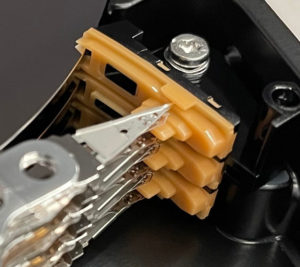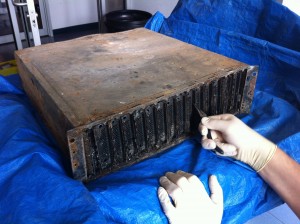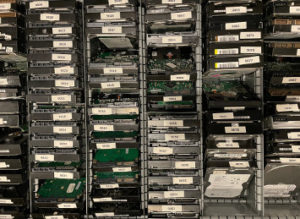
The actuator heads of a hard drive.
Enterprise and consumer-class hard drives are built for vastly different workloads. The average consumer probably won’t benefit from a HAMR (Heat Assisted Magnetic Recording) drive, for example, and Shingled Magnetic Recording (SMR) is overkill for most consumer applications — but if you’re building a server, those hard drives might be worth the investment.
Hard drive design philosophies directly affect how we approach data recovery. Consumer drives are built for affordability; enterprise HDDs are high-endurance tools designed for 24/7 server environments.
Understanding these distinctions explains why a failure on a server drive can be far more complex to resolve than a similar failure on a desktop PC. We’ll break down the three main areas that matter in a data recovery lab.
Datarecovery.com operates real laboratories at every location — no mailing offices — and we support all services with free evaluations and a no data, no charge guarantee. To learn more, call 1-800-237-4200 or submit a ticket online.
Consumer vs. Enterprise HDDs: Hardware Durability and Build Quality
If you’ve never dealt with an enterprise hard drive, the most significant difference is in the physical construction. Enterprise drives are built to withstand the intense operational demands of a data center — so they’re less likely to fail from simple motor burnouts, bearing seizures, or other common physical data loss scenarios.
Enterprise drives are rated for 24/7 operation and have a much higher Mean Time Between Failures (MTBF). They also include features like rotational vibration sensors that detect and counteract vibrations from neighboring drives, preventing performance degradation and read/write errors in a dense server environment.
But while enterprise drives are physically tougher, their high-performance components tend to be more complex. When a robust enterprise drive does suffer a mechanical failure (for example, a head crash), the internal damage can be severe due to higher spin speeds and tighter tolerances.
For consumer drives, physical failures are more common but often more predictable for our engineers to address. Additionally, consumer drives are more common — so we treat more of them in our laboratories and have more robust case histories to draw from.
This doesn’t mean that enterprise hard drives have lower recovery success rates. In fact, success rates can be higher depending on the model — and its use case. Enterprise drives are almost always in RAID systems, and redundant data systems can withstand a single drive failure. That means that when we receive the case, we may have multiple potential paths for a successful recovery.
Firmware Considerations: Enterprise vs. Consumer Hard Drives

Our engineer removing a hard drive from a fire-damaged RAID.
Firmware is the drive’s internal operating system. The firmware on a consumer drive is complex, but it’s relatively standardized across product families. It contains modules for managing bad sectors, reading and writing data, and performing other essential tasks.
Enterprise HDD firmware is substantially more complex. It’s sometimes customized for specific RAID controllers or server systems, and it might contain hundreds of proprietary modules for performance tuning, deep environmental analytics, and advanced security protocols.
Firmware corruption is a common cause of hard drive failure. On a consumer drive, our engineers can use specialized tools to access the drive’s service area (a hidden part of the platters where firmware resides) and repair the corrupt modules.
For enterprise drives, this process is more challenging. Accessing the service area often requires bypassing proprietary security locks, and repairing the firmware means reverse-engineering unique, undocumented modules. Our R&D team spends a significant portion of its time developing new tools just to interface with the firmware of the latest enterprise drives.
Error Handling and RAID Stability
Some enterprise drives feature a technology called Time-Limited Error Recovery (TLER, specific to Western Digital drives), also known as Error Recovery Control (ERC) or Command Completion Time Limit (CCTL, specific to Samsung and Hitachi drives).
With TLER, the drive will only try to read a bad sector for a very short, specific time (usually about 7 seconds). If it can’t, it stops trying and immediately reports the error to the RAID controller. The controller can then use parity data from the other drives to reconstruct the missing data and continue functioning seamlessly.
The lack of TLER is a primary reason why using consumer-grade drives in a business-critical RAID system is a bad practice. During the recovery process, understanding a drive’s error handling behavior is vital for creating a stable, sector-by-sector image of the platters.
For enterprise drives with media damage, we have to use specialized hardware that can manage these error reports to acquire the fullest and cleanest image possible.
Data Recovery Services for All Hard Drive Classes

A drawer full of Hitachi, Maxtor, and Seagate 3.5 inch hard drives.
The bottom line: Consumer drives fail more often, but their issues are typically less complex. Enterprise drives are resilient, but when they fail, their proprietary firmware and advanced hardware can complicate data recovery.
At Datarecovery.com, our labs are equipped to handle all types of hard drives, solid state drives, RAID controllers, and other storage media technologies. We have decades of experience and invest heavily in the research and development required to treat complex failure scenarios on high-capacity enterprise SAS and SATA drives.
Our risk-free evaluation ensures that we can properly diagnose the drive’s failure at the outset of each ticket — providing you with total peace of mind as your case progresses.
If you have a failed consumer or enterprise hard drive, we’re here to help. For a free evaluation, contact our specialists at 1-800-237-4200 or submit a case online.




